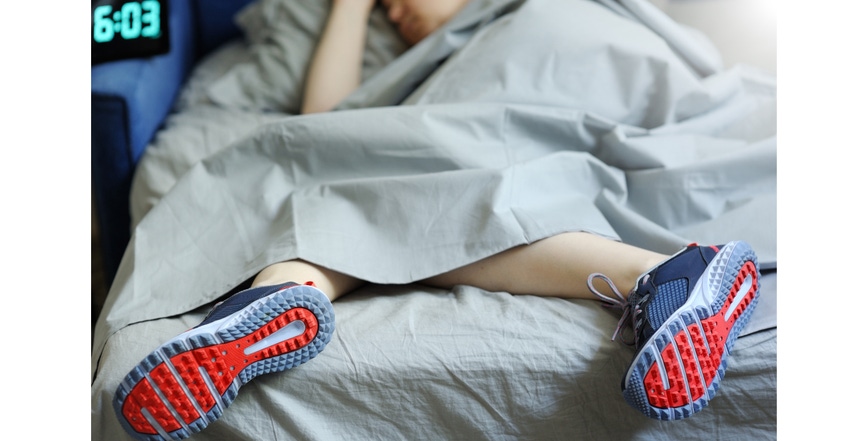Ingredients that boost sleep in athletes
Minerals and specialty nutrients—arginine, glycine, 5-HTP, melatonin and more—help boost sleep in athletes, leading to improved sports performance.

Sleep loss can have profoundly negative effects on sports performance. Sleep has specific important physiological and cognitive functions for the athlete. The body restores itself during sleep, so it is necessary for recovery from intense training.1 Even small amounts of fatigue can significantly reduce reaction time, attention, focus and physical recovery,2 worsening athletic performance. Compromised sleep may also influence injury proneness, learning, memory, cognition, pain perception, immunity and inflammation.3
During sleep, muscles and the central nervous system (CNS) recover from the activity from the day before.4 The CNS is responsible for pain response, reaction time, and muscle contractions—all important for athletic performance. Additionally, deep sleep is when most of the body’s human growth hormone is released, which is necessary for muscle recovery, muscle growth and sustained performance.5 The research also suggests that lack of sleep increases levels of the stress hormone cortisol.6
Arginine and glycine
Arginine and glycine support healthy nitric oxide (NO) production,7 which is essential for circulatory flow to support the delivery of nutrients to the cell and the removal of metabolic toxins. NO causes blood vessels to dilate and improve circulatory status. It is also widely accepted that NO facilitates sleep.8
NO is intimately involved in non-rapid eye movement (REM) sleep and sleep homeostasis.9 In one study, it was found that inhibition of NO synthesis, one of the pathways that creates NO, suppressed spontaneous sleep.10
At night, levels of cyclic guanosine monophosphate are higher, which suggests an increase in NO.11 It is known that increased levels of NO results in increased levels of cyclic guanosine monophosphate. It is through this relationship that another study proposed NO and cyclic guanosine monophosphate are involved in the circadian rhythm.12 Lower levels of NO are also associated with sleep apnea.13
For athletic performance, the amino acids arginine (direct NO precursor) and glycine (indirect NO booster) are vasodilators; the blood flow allows the heart to pump blood more efficiently, which can promote cardiovascular and muscular performance.7 Arginine can also promote the release of growth hormone and insulin, which support lean muscle mass and energy production from glucose.14 This improved utilization of glucose can be used for increased growth and energy demands.
5-Hydroxytryptophan (5-HTP)
5-Hydroxytryptophan (5-HTP) is an amino acid made naturally in the body. It is also produced as a supplement from the seeds of a plant, Griffonia simplicfolia, native to West Africa. This compound has effects on both sleep and mood. 5-HTP is converted in the brain to serotonin, an important neurotransmitter that can initiate sleep. One of the key benefits of 5-HTP is its ability to increase REM sleep by up to 25%, while increasing deep sleep stages three and four.15
5-HTP can also be useful for performance anxiety that can raise levels of the stress hormone cortisol, causing symptoms such as difficulty breathing, a rapid heartbeat or tightened muscles. 5-HTP helps the body replenish its stocks of serotonin, which is also involved in processing emotion, mood and appetite, to counteract the effects of higher levels of cortisol and reduce the impact of the physical and psychological symptoms.16
Melatonin
Melatonin is a hormone released by the pineal gland that increases at night to prepare the brain for rest and sleep.17 The pineal gland is directly connected to the optic nerves; it is in direct contact with light. The pineal is inactive during the day. When the sun goes down, the pineal is "turned on" and begins to actively produce melatonin, which is released into the blood. As a result, melatonin levels in the blood rise sharply and drowsiness occurs. Melatonin levels in the blood stay elevated for about 12 hours throughout the night until the light of day, when they fall back to low daytime levels. That’s why melatonin is referred to as the hormone that regulates the wake/sleep cycle, the body clock also referred to as circadian rhythm. In the daytime, when exposed to sunlight, melatonin levels are then suppressed, promoting alertness.
Melatonin is one of the most powerful antioxidants known.18 It reduces stress, inflammation and cellular apoptosis and to restore tissue function, also having a significant effect on immune function.19
Valerian
Valerian is an herb that may help improve sleep, promote relaxation and reduce anxiety.20 It contains several compounds that include valerenic acid, isovaleric acid and a variety of antioxidants. Valerian interacts with gamma-aminobutyric acid (GABA), a neurochemical messenger. Low GABA levels are related to acute and chronic stress, and are also linked to anxiety and low-quality sleep.21 Valerenic acid has been found to inhibit the breakdown of GABA in the brain, resulting in calmness and tranquility.22
Valerian root also contains the antioxidants hesperidin and linarin, which have sleep-enhancing properties. These compounds may inhibit excessive activity in the amygdala, an area of the brain that processes fear and strong emotional responses to stress. Research suggests that taking valerian root may reduce the amount of time it takes to fall asleep, as well as improve sleep quality and quantity.23
Magnesium
Magnesium also plays a role in supporting deep, restorative sleep by maintaining healthy levels of the neurotransmitter GABA to promote sleep and quiet down nerve activity.24 It also regulates melatonin.25
In order to fall asleep and stay asleep, the body and brain need to relax. On a chemical level, magnesium aids this process by activating the parasympathetic nervous system responsible for relaxation.26 Magnesium regulates the calming neurotransmitters, which send signals throughout the nervous system and brain.
Virtually every bodily function requires adequate levels of magnesium. Magnesium is a cofactor in more than 300 enzyme systems that regulate diverse biochemical reactions in the body, including protein synthesis, muscle and nerve function, blood glucose control and blood pressure regulation.27 Magnesium deficiency is associated with heightened stress and anxiety.25
Taurine
Taurine is an amino acid derivative that plays a key role in neurotransmitter regulation, helping to calm and stabilize the nervous system.28 It reduces cortisol levels and increases the production of GABA . Taurine levels are concentrated in the brain. Because of its ability to generate nerve impulses, stabilize nerve cell membranes and prevent erratic firing of nerve cells, taurine helps calm stress and anxiety.29 It also reduces the effects of training stress and helps prevent muscle breakdown.30
Jack Grogan is chief science officer for Uckele Health & Nutrition. He is an expert in hair mineral analysis, a tool in determining the causes of nutritional imbalances or deficiencies. With experience in the fields of biology, biochemistry and nutrition, he has influenced the development of hundreds of proprietary nutritional formulas and programs.
References
Halson S. “Sleep in elite athletes and nutritional interventions to enhance sleep.” Sports Med. 2014;44 Suppl 1(Suppl :S13–S23. DOI:10.1007/s40279-014-0147-0
Alhola P, Polo-Kantola P. “Sleep deprivation: Impact on cognitive performance.” Neuropsychiatr Dis Treat. 2007 Oct; 3(5): 553–567.
Copenhaver E, Diamond A. “The Value of Sleep on Athletic Performance, Injury, and Recovery in the Young Athlete.” Pediatr Ann. 2017 Mar 1;46(:e106-e111. DOI: 10.3928/19382359-20170221-01.
Taheri M, Arabameri E. The effect of sleep deprivation on choice reaction time and anaerobic power of college student athletes. Asian J Sports Med. 2012;3(1):15–20.
Godfrey RJ et al, The exercise-induced growth hormone response in athletes. Sports Med. 2003;33(8):599-613
Morgan E et al. “Sleep Characteristics and Daytime Cortisol Levels in Older Adults.” Sleep. 2017 May 1;40(5). DOI: 10.1093/sleep/zsx043.
Venkatesh R, Srinivasan K, Singh S. “Effect of arginine:lysine and glycine:methionine intake ratios on dyslipidemia and selected biomarkers implicated in cardiovascular disease: A study with hypercholesterolemic rats.” Biomed Pharmacother. 2017 Jul;91:408-414. DOI: 10.1016/j.biopha.2017.04.072.
Gautier-Sauvigne S et al. “Nitric oxide and sleep.” Sleep Med Rev. 2005 Apr;9(2):101-13. Review.
Bain A et al. “Insufficient sleep is associated with impaired nitric oxide-mediated endothelium-dependent vasodilation.” Atherosclerosis. 2017 Oct;265:41-46. DOI: 10.1016/j.atherosclerosis.2017.08.001.
Kapás L, Fang J, Krueger J. “Inhibition of nitric oxide synthesis inhibits rat sleep.” Brain Res. 1994 Nov 21;664(1-2):189-96.
Langmesser S et al. “cGMP-dependent protein kinase type I is implicated in the regulation of the timing and quality of sleep and wakefulness.” PLoS One. 2009;4(1):e4238. DOI: 10.1371/journal.pone.0004238.
A. V. Kalinchuk. “Nitric oxide production in the basal forebrain is required for recovery sleep.” J Neurochem. 2006 Oct;99(2):483-98.
Badran M et al. “Nitric Oxide Bioavailability in Obstructive Sleep Apnea: Interplay of Asymmetric Dimethylarginine and Free Radicals.” Sleep Disord. 2015;2015:387801. DOI: 10.1155/2015/387801.
Zajac A et al. “Arginine and Ornithine Supplementation Increases Growth Hormone and Insulin-Like Growth Factor-1 Serum Levels After Heavy-Resistance Exercise in Strength-Trained Athletes.” J Strength Cond Res. 2010 Apr;24(4):1082-90. DOI: 10.1519/JSC.0b013e3181d321ff.
Wyatt R et al. “Effects of 5-hydroxytryptophan on the sleep of normal human subjects.” Electroencephalogr Clin Neurophysiol. 1971 Jun;30(6):505-9.
Birdsall T. “5-Hydroxytryptophan: A Clinically-Effective Serotonin Precursor.” Altern Med Rev. 1998 Aug;3(4):271-80.
Claustrat B, Leston J. “Melatonin: Physiological effects in humans.” Neurochirurgie. 2015 Apr-Jun;61(2-3):77-84. DOI: 10.1016/j.neuchi.2015.03.002.
Redwine L et al. “Effects of Sleep and Sleep Deprivation on Interleukin-6, Growth Hormone, Cortisol, and Melatonin Levels in Humans.” J Clin Endocrinol Metab. 2000 Oct;85(10):3597-603.
Reiter J et al. “Melatonin as an antioxidant: under promises but over delivers.” J Pineal Res, 2016 Oct;61(3):253-78. doi: 10.1111/jpi.12360.
Bent S et al. “Valerian for sleep: a systematic review and meta-analysis.” Am J Med. 2006 Dec;119(12):1005-12.
Maguire J. “The relationship between GABA and stress: 'it's complicated'.” J Physiol. 2018 May 15;596(10):1781-1782. DOI: 10.1113/JP275937.
Meyerhoff D et al. “Cortical gamma-aminobutyric acid and glutamate in posttraumatic stress disorder and their relationships to self-reported sleep quality.” Sleep. 2014 May 1;37(5):893-900. DOi: 10.5665/sleep.3654.
Houghton P. “The scientific basis for the reputed activity of Valerian.” J Pharm Pharmacol. 1999 May;51(5):505-12
Poleszak E et al. “Benzodiazepine/GABA(A) receptors are involved in magnesium-induced anxiolytic-like behavior in mice.” Pharmacol Rep. 2008 July -Aug;60(4):483-9.
Abbasi B et al. “The effect of magnesium supplementation on primary insomnia in elderly: A double-blind placebo-controlled clinical trial.” J Res Med Sci. 2012 Dec;17(12):1161-9.
Wienecke E et al. “Long-term HRV analysis shows stress reduction by magnesium intake.” MMW Fortschr Med. 2016 Dec;158(Suppl 6):12-16.
Long S, Romani A. “Role of Cellular Magnesium in Human Diseases.” Austin J Nutr Food Sci. 2014 Nov 18;2(10). pii: 1051.
Wu JY, Prentice H. “Role of taurine in the central nervous system.” J Biomed Sci. 2010;17 Suppl 1(Suppl 1):S1. Published 2010 Aug 24. DOI:10.1186/1423-0127-17-S1-S1
Wu G et al. “Antidepressant effect of taurine in chronic unpredictable mild stress-induced depressive rats.” Sci Rep. 2017 Jul 10;7(1):4989. DOI: 10.1038/s41598-017-05051-3.
About the Author(s)
You May Also Like






.png?width=800&auto=webp&quality=80&disable=upscale)